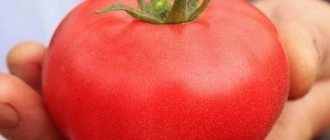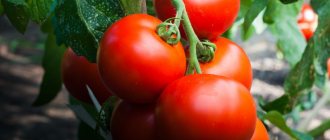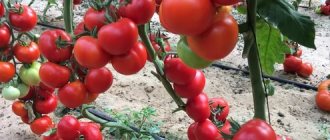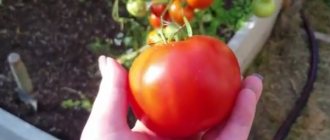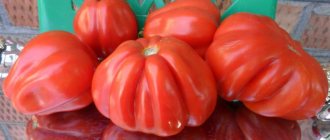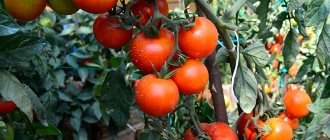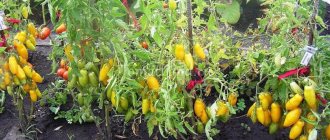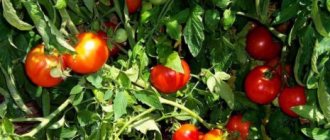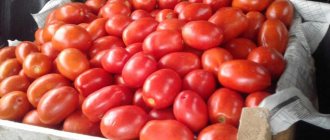| Ripening period: | early |
| Fruit shape: | heart |
| Color: | crimson |
| Weight: | 0.25 kg |
| Productivity: | 5-8 kg per square meter |
The determinate tomato Velmozha is an early ripening variety of Russian origin. Along with high yield, tomatoes are characterized by good adaptation to growing conditions. Plants can be planted in greenhouse buildings, greenhouses and outside shelter without loss of productivity. It is worth taking a closer look at the varietal data, the positive and negative aspects, and the subtleties of planting.
Characteristics and description of the variety
Mostly varietal tomatoes grow well in warm areas, but do not withstand the cool climate of the north of the country. One of the frost-resistant species is the Velmozha tomato, the characteristics and description of which were included in the State Register in 2005. Optimal regions for cultivation:
- Siberia;
- Ural;
- Far East.
Plants of this variety:
- grow up to 0.7 m without shelter, up to 1.4 m in a greenhouse;
- require tying due to weak stems;
- need to form a bush;
- have complex inflorescences every 1-2 leaves, starting from 7;
- ripen in 103-117 days.
The variety is not suitable for cultivation on an industrial scale, but has good performance in summer cottages or garden plots in closed and open ground.
Fruit
Velmozha tomatoes are large-fruited varieties. Seed nests in fruits of 4 or more, with a small amount of moisture. The seeds have time to ripen and retain all the properties of the variety. The pulp of tomatoes is dense and fleshy, with almost no voids in the cut.
The appearance of the fruit resembles a heart with a wide top and a sharp elongated end. The shape resembles the tomatoes Pudovik, Alsou, and Bull's Heart.
Tomatoes ripen in bunches, each of which contains up to 10 pieces. The durable raspberry-colored peel is not prone to cracking.
Tomatoes store well and do not lose their shape during transportation. In addition, tomatoes have an attractive shape and uniform size, as can be seen from the photo of the fruit.
Taste qualities
The main advantages of the Velmozha variety relate not only to large fruit, but also to taste. Tasting rating of tomatoes 8.6 out of 10. The pulp of the fruit has a rich, bright taste. The sugar content of a tomato is 3-4.5%, which is facilitated by its low acid content.
The bright taste of the fruit is preserved even after processing, thanks to the large amount of dry matter in the range of 4-6%.
Productivity
According to reviews of the Velmozha tomato, the smallest fruits weigh no less than 150 g, and the largest ones grow to a record 800 g. Although most tomatoes have similar sizes and an average weight of about 250 g.
According to agricultural data, when growing tomatoes in the Urals and Siberia, you can get about 0.4 tons of fruit per hectare of plantings. The yield of Velmozha in the middle zone reaches 0.7 tons. High-quality fruits make up 95% of the total harvest.
Usage
Based on the reviews, we can draw a conclusion about the scope of application of Velmozha tomatoes:
- Large, uniformly sized tomatoes are suitable for canning due to their dense flesh and tough skin.
- The low free liquid content and pleasant taste allow the fruits to be used in salads and fresh snacks.
- A high proportion of dry matter is optimal for processing tomatoes into pastes, sauces or ketchup.
The low acid content in combination with vitamins and minerals allows the crop to be used for preparing baby food or diet food.
Noble's Productivity
The Velmozha tomato is productive. About 10-15 kg are harvested per bush per season, 20-30 kg per square meter, 300-500 centners of tomatoes can be harvested per hectare in Siberia and the Urals, and in the middle and southern regions - 600-700 centners of tomatoes.
Despite the fairly high yield of the variety, many gardeners increase it with some agrotechnical techniques. So, what factors can increase productivity:
About 10-15 kg are collected from a bush per season
- Forming a bush with 2 stems.
- Quality care. It increases not only the yield, but also the weight of the fruit (record holders reach 1 kg).
- Potassium-phosphorus fertilizing during flowering and fruit ripening.
Interesting!
To get larger fruits, you need to pinch off excess clusters and leave up to 5 buds on the shoot.
Growing seedlings
Seeds for planting can be purchased at the store, and subsequently prepared independently.
The Velmozha tomato variety is not a hybrid variety, so the seeds of the fruit retain all the properties of the plant. When purchasing, you should pay attention to the expiration date and information on the packaging.
Before planting, seeds should be inspected for plaque or damage, and defective ones should be removed.
Disinfection of the material is carried out by soaking in a weak solution of hydrogen peroxide or potassium permanganate.
You can improve the resistance of the Nobleman through the hardening procedure, for which the seeds are placed in the refrigerator or freezer for 12 hours, and then returned to room temperature for 12 hours.
For planting seedlings, you can use any universal soil composition rich in nutrients. The store-bought mixture can be placed in containers immediately, and manually prepared soil should be disinfected with boiling water 10 days before planting the seeds.
Both wooden and plastic containers are suitable for seedlings.
Seed material is planted 2 months before the planned move to a permanent place. The seeds are planted in moist soil in holes 1 cm deep, one at a time at a distance of at least 4 cm from each other, after which they are sprinkled with soil. The container is covered with transparent material and placed in a warm place with diffused light. The cover is removed after 14 days. If there is a lack of natural light, it is worth installing additional fluorescent lamps.
An important condition for the growth of seedlings is proper care. Plants need not only warmth, but also maintenance of soil moisture. Watering must be done carefully so as not to damage the noble sprouts.
14 days after the emergence of seedlings, additional fertilizers can be added to the soil. It is advisable to use nitrogen compounds that provide rapid growth of green mass. If necessary, fertilizing is carried out weekly.
Landing in the ground
Velmozha tomatoes can be planted in open or closed ground. The growing method affects the height of the plants and the speed of fruit ripening.
It is advisable to choose a plot for tomatoes in such a way as to maintain proper crop rotation. The best precursors for culture are:
- legumes;
- cucumbers;
- carrot;
- onion;
- garlic.
It is important to choose the right soil composition or improve the soil using additives. Before planting, the soil needs to be loosened and the following added:
- rotten compost;
- wood fly ash;
- wet sawdust;
- fertilizers with phosphorus and potassium.
It is recommended to dig up the garden for Velmozha tomatoes 5-6 days before planting the seedlings, so that the soil is well mixed and settled. To disinfect, you can pour boiling water over the beds with the addition of a solution of copper sulfate.
Depending on the climate, Velmozhi seedlings are planted in a permanent place in May or June. In closed ground conditions, the period can be shifted by 2 weeks.
The plant placement pattern should not be dense; no more than 3 bushes should be planted on each square meter. The holes are placed at a distance of 0.4 m, and at least half a meter of free space is left between the beds. The planting depth is selected in accordance with the volume of the roots, which on average is 6-8 cm.
Features of care
As Velmozha tomatoes grow, they require compliance with watering standards and care rules, including:
- regular loosening of the soil;
- weed removal;
- fertilization;
- bush formation;
- pest protection;
- disease prevention.
Watering
Velmozha tomatoes need regular, abundant watering throughout the growing season to gain green mass, as well as to form a harvest. Large-fruited tomato varieties are especially demanding of moisture during the period of weight gain. Uniform watering has a positive effect on the shape of the fruit. It is enough to perform the procedure once a week, increasing the frequency only during heat or drought.
For normal growth of tomatoes, a bucket of warm water for each square meter of planting is enough. The temperature of the liquid should not be low, preferably within 22-24°C. And during ripening, when the skin of the fruit begins to turn red, the volume of moisture should be reduced.
After each watering, it is recommended to loosen the soil. This procedure accelerates the delivery of water and oxygen to the roots of the tomato. To keep the soil moist, the beds can be mulched with peat or hay.
Stepsoning
The tomato variety Velmozha definitely needs pinching. First of all, you should remove the stepsons located under the brushes before flowering begins. The growth of these shoots takes away nutrients, which causes the inflorescences to die before the ovaries form.
The branches should not be pulled out; it is better to break them evenly or cut them with a garden tool, keeping the short stump. In this case, a new shoot will not be able to appear at the cut site.
The Velmozha variety is characterized by intensive growth of green mass, which leads to the constant appearance of new branches and leaves that will have to be removed throughout the growing season.
Bush formation
Proper plant formation significantly increases productivity, increases yield and allows the tomato to gain more weight. The bush must be freed from lower daughter shoots and excess foliage. The procedure is carried out before the formation of buds begins; at a later time, this will lead to the slow formation of ovaries.
For plants to be grown in open ground, 1 stem is retained; in greenhouses, 1-2 are left. Towards mid-August, you need to pinch the top of the bush to limit growth. In this case, the main energy of the plant will be directed to enlarging the fruits. At the same time, you can cut off the brushes on which the ovary is missing, since tomatoes will no longer appear there in the future.
Velmozhi bushes must be tied up, as the fragile shoots easily break under the weight of heavy fruits. Pegs up to 1.5 m high are installed at a distance of 8-12 cm from the center of the hole when planting seedlings in a permanent place.
Fertilizers
In order to grow a large and high-quality harvest of Velmozha tomatoes, you will have to take care of the constant application of fertilizers to the soil. The crop is demanding on nutrition and quickly depletes the soil. Recommended feeding schedule:
- On the 14th day after planting the seedlings, a universal fertilizer containing potassium and phosphorus should be applied.
- When the first pair of inflorescences appears, superphosphate and potassium sulfate should be added to the same preparation.
- At the time of flowering of the third cluster, the universal remedy is combined with nitrophoska.
- It is recommended to do the last feeding after 2 weeks. It is enough to add a little superphosphate to the soil.
During prolonged heavy rains, Velmozha in open ground should be protected from excess moisture. To do this, you can use a preparation for roots - “Kornerost”. Application of any type of fertilizer should be stopped 2 weeks before the start of harvest.
When growing the Velmozha variety in a greenhouse, fertilizers are applied in spring and autumn when digging the soil. And also once every 2 years the soil is completely replaced with a new one.
History of selection
Novosibirsk breeding scientists have developed and bred a new variety of vegetable crop. The Siberian hybrid form of tomatoes has received unique natural protection from frost and adverse weather conditions. Thanks to its improved characteristics, the variety completed state tests in 2005 and was zoned in all regions of the country for cultivation, both in open ground and in greenhouse complexes.
Most gardeners and gardeners believe that the Velmozha tomato has a second name, Budenovka, but this opinion is erroneous. According to the authors of Velmozhi, Budenovka tomatoes are a completely separate variety of vegetable crop, although they have external and taste similarities.
Important! In terms of appearance and taste, Velmozha tomatoes are similar to varieties of southern tomatoes. But the cold-resistant culture is completely unadapted to the southern climate.
Optimal regions for cultivation:
- Siberia;
- Ural;
- Far East.
Diseases and pests
The main disadvantages of Velmozha tomatoes are the variety’s susceptibility to pest attacks. It is quite difficult to pre-protect tomatoes in open ground from insects. Spider mites pose a danger to plants. The pest eats leaves, young shoots and ovaries, which can even lead to the death of the bushes. The easiest way to get rid of this insect is to treat it with soapy water. But in case of extensive infestation, it is better to add mild insecticidal preparations.
One of the advantages of the Velmozha variety is good immunity developed over years of selection. But still, a tomato can be infected with infections such as:
- Late blight. The most common disease of cultivated plants leads to serious infection and loss of the crop. Fungal spores fall on plants with gusts of wind, penetrate inside the stems, and infect leaves and fruits with dark spots with a white coating. You can save plants by spraying with a solution of potassium permanganate, an infusion of tobacco leaves, or fungicides.
- Brown spot. After prolonged rainfall or due to excess watering, the bushes may become covered with brownish-red spots. To eliminate the problem, you need to equip drainage grooves for water, and also spray the plants with an infusion of garlic or wood ash.
- Verticillium. The disease leads to lethargy or yellowing of the lower leaves, which weakens the growing season and inhibits the development of fruits. Damaged areas need to be removed, and the roots of the tomatoes should be watered with a solution of nitrogen fertilizers.
Preventive measures to combat insects and diseases:
- compliance with the water regime;
- weed removal;
- providing sunlight.
Video
You can see a short video review of the “Velmozha” tomato variety below:
| Super early | Mid-early | Late ripening |
| Alpha | King of the Giants | Premier |
| Pickling miracle | Supermodel | Grapefruit |
| Labrador | Budenovka | Yusupovsky |
| Bullfinch | Bear Paw | Rocket |
| Solerosso | Danko | Digitomandra |
| Debut | King Penguin | Rocket |
| Alenka | emerald apple | Snowfall F1 |
Advantages and disadvantages of the variety
The main advantages of the Velmozha tomato according to reviews and photos:
- Tomatoes are endowed with juiciness and bright taste.
- Large fruits are not prone to cracking.
- Universal use of the crop in cooking.
- Low temperature resistance.
- Rapid adaptation of seedlings to growing conditions.
- Short growing season.
- The fruits retain their appearance and density during short-term storage and transportation.
- The seeds contain complete genetic material and are suitable for planting next year.
Among the disadvantages, Nobles note:
- During growth, the bushes require constant pinching.
- Weak stems cannot support the weight of tomatoes and therefore need support.
- Susceptibility of the variety to some fungal infections.
- High requirements for the composition and nutritional value of the soil, as well as access to moisture and oxygen.
